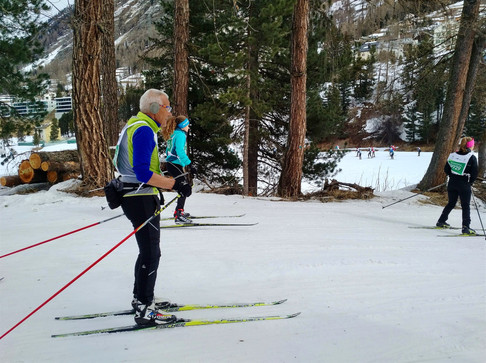October 13, 2020
- Athena Lucero

- Oct 12, 2020
- 3 min read
Updated: Oct 15, 2020
A Covid winter is coming.

With a passion for winter sports -- snow shoeing, downhill skiing, and cross-country skiing (also called Nordic skiing) -- it’s the only time I regret not living closer to snow country. In particular, cross-country trails.
A year before the novel coronavirus dropped like a bomb around the world, a writing assignment on cross country skiing landed me at the world’s second largest cross-country ski competition – the annual Engadin Skimarathon in the Swiss mountain villages of St. Moritz and Pontresina. I was there to learn all that I could about the sport and its origins as well as to take a class under the tutelage of a pro in hopes of one day breaking out of my beginner level rut.

The more I think about how easy it is to get onto cross-country trails, the more I realize how, no pun intended, “Covid-friendly” the sport is. It’s easy to social distance because crowds are virtually non-existent. All you need are skis, lightweight boots, poles, lightweight winter clothing, and flat terrain covered with snow. Unlike downhill (or alpine) skiing, you don’t need a lift ticket to get onto the mountain and onto chairlifts. Just find a trail, click the tips of your boots into the skis and you’re off.
What a dream it would be to isolate at a lodge for the season.

While I’m passionate about downhill skiing, ski and snowboard resorts everywhere will welcome guests this winter with new Covid protocols for reserving lift tickets, riding chairlifts, wearing masks, social distancing, and limiting skiers on the mountain. Once you get passed these new hoops, it will be worth it all to schuss down the slopes as free as a bird on less crowded trails.
But for me, the tranquility of gliding alone on flat snow-covered terrain, completely unrushed and surrounded more by nature than people, is just what the coronavirus experts have ordered.
All that I hear is my heavy breathing as I push one ski in front of the other. If you can walk, you can cross country ski, the saying goes. At the same time, Nordic skiing is considered to be the toughest sport and the best cardio workout. Unlike downhill skiing where gravity does all the work, I have to call on every muscle group in my body to get moving.
The trail looks flat – compared to a downhill ski run. But “flat” terrain is full of inclines and declines. I persevered even during a wet and messy snowfall. After my lesson, I respect this sport even more because it’s a lot harder to master than it looks.
My one hour with Daniel was the best cross-country ski lesson I have ever taken. As we headed back to the Langlaufzentrum (ski school) along a very flat stretch, I felt the rhythmic glide even if only for a few strides. “I’ve got it!” I yelled to Daniel.

And I will never forget the email I received from my Swiss contact informing me that all levels of skiers 16 and older can enter the annual 26-mile race. An 86-year old woman who has skied the race every year since it began 50 years ago, will be racing again, she told me. “Would you like to enter?” she asked. “There is a half-marathon women’s race.” Um, “I’ll think about it,” I graciously replied.
The next time I resume cross country ski lessons, there’s no where else I’d rather be than in the Engadin.
Winter is coming.
















Comments